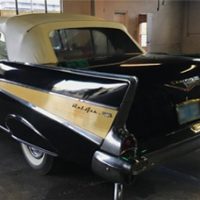Chevrolet Bel Air

The Bel Air may have been one of the first true Chevrolets. After World War II, General Motors wanted to make this division synonymous with practical luxury. The 1957 Bel Air was a good example, It retailed for about $2,200, making it a costly vehicle but not nearly as expensive as some other GM cars.
This signature Chevrolet was on dealer lots from 1951 through 1975 (1981 in Canada), making it one of the longest-running vehicle models ever. For both a returning World War II veteran and a coming-of-age Baby Boomer, a new Bel Air in the garage may have been the ultimate status symbol.
First Generation Bel Airs (1950-54)
GM marketed these cars as convertibles with non-detachable solid roofs. The concept had been around since the 1920s, but GM had never pulled the trigger on production. It took a while for customers to warm up to the idea. But GM stuck with the plan, and that style became standard for several decades.
Later models in this generation featured different trim, most notably around the grille and taillights. Starting around 1953, the Bel Air also had the signature chrome steering wheel with chrome ring. Other innovations included power steering, which must have been a very nice addition in a beast like the Bel Air. Other body styles, like a convertible and a station wagon, became available as well.
Second Generation Bel Airs (1955-57)
The “hot one” was one of the first Chevrolets with an optional V8 engine. This overhead valve engine was so successful that it remained in production for a number of years. There were other upgrades as well, like a new transmission system and better overall handling.
Leading industry magazines gave the second generation Bel Airs very high marks. But these cars were not perfect. The wide steering wheel limited visibility, the engine knocked, and the car burned lots of oil. So, later models received facelifts. They also had more safety features as well, such as optional padded dashboards and seat belts. But fewer than 8 percent of Bel Air buyers requested restraint systems.
Third Generation Bel Airs (1958-60)
As the 1950s drew to a close, customer preferences were changing. Previously, Bel Air customers wanted to show off their new rides. But the Baby Boomers who bought these cars in the late 50s thought about settling down and raising families. Therefore, the Bel Air had to change.
Chevrolet responded with redesigned cars made entirely of sheet metal forged onto redesigned frames. A lower roofline and headlights improved visibility. There were also more options in terms of speed and horsepower. Basically, there were family-style Bel Airs and hotrod Bel Airs. Previously, only the latter type had been available.
Later generation Bel Airs lost that rounded look and had much more utilitarian appearances. Under the hood, however, they remained much the same. That longevity and consistency may have been the things that gave the Bel Air such a special place in the hearts of millions.








